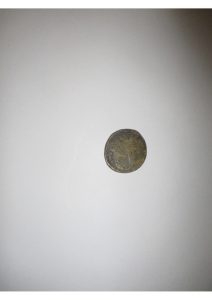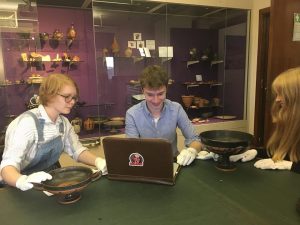Bill Cook, BA Archaeology and Ancient History student, outlines his experiences of volunteering at the CAHA museum. This is a museum in the Arts Building at the University of Birmingham which holds a collection of approximately 2000 examples of Greek, Mycenean, Roman and Egyptian pottery, funerary, domestic and religious objects. In addition to the objects on display in the Archaeology Museum room, the collection contains a large and valuable range of pot sherds, assembled throughout the 20th Century.
The collection is used for a wide variety of teaching including undergraduate and postgraduate teaching in CAHA, cross-disciplinary courses and outreach master classes for secondary schools.
Having volunteered at the CAHA museum for two academic years I have been working on numerous projects to make the museum more accessible for teaching and students. The experience has been challenging and eye opening having to learn about objects from Egypt, Crete, Greece and Rome just to name a few.
In my first year of volunteering another and I were delegated to work with the Roman and Greek coin collection. The collection itself is a mystery with the provenance of these coins being unknown. Having no knowledge of Latin prior to starting with the collection I had to learn the basics of the language in regards to abbreviations of magistrate positions often depicted on coins.
For example, there is one coin that I had to look at but its condition was incredibly poor. The obverse of the coin has two heads and the abbreviation IMP which stands for imperator. Looking on the reverse on the coin I was able to spot a crocodiles tail and the word COL meaning a colony of Rome. By researching the characteristics of the coin I found out that it dated between 10 B.C-A.D 10 finding clearer examples to show that the two busts are of Augustus and Agrippa with the crocodile being chained to a palm tree. The crocodile is believed to have connotations with the defeat of Cleopatra and the subjugation of Egypt in 31 BC.1 The coin itself was minted in Gaul as the colonies name was Nemausus demonstrating the vastness and interconnected nature of early Empire Rome. It is truly fascinating how much an everyday object can tell us about the history of past societies and this is simply one story out of the several thousands of objects present at the museum. In addition, holding a piece of history opens up further appreciation of these ancient societies. They become more human and relatable.


This year the museums goal has been working on finding and locating all items under our collection. Working with a small group to go through the display cases reading numbers written on objects to identify where they originally come from and if they are apart of our collection or Birmingham’s Museum within the city centre. Further, each item is described and analysed in depth to ensure the best possible resource is created for the museum and students.

Volunteering at the museum has opened doors for me in so many ways. I have increased my knowledge of Latin and my independence in being able to research projects for sustained periods, which in turn has helped me prepare for my dissertation in my final year. My knowledge of Excel and other important programmes have greatly improved my skills in I.T due to their use in cataloguing items. I would highly recommend to students to take up the opportunity to volunteer for two hours a week as the skills and experience you learn add another layer to your degree and university life.
Bibliography
‘Photograph of an Augustan Coin within the museums collection’ (photograph: B. Cook).
CAHA UoB TWITTER ‘Photograph of CAHA Museum Volunteers’, posted 28/11/18. https://twitter.com/CAHA_UoB (Accessed 28 December 2018).
WILDWINDS. ‘Ancient Coinage of Gaul, Nemausus’, http://www.wildwinds.com/coins/greece/gaul/nemausus/i.html (Accessed 28 December 2018).
